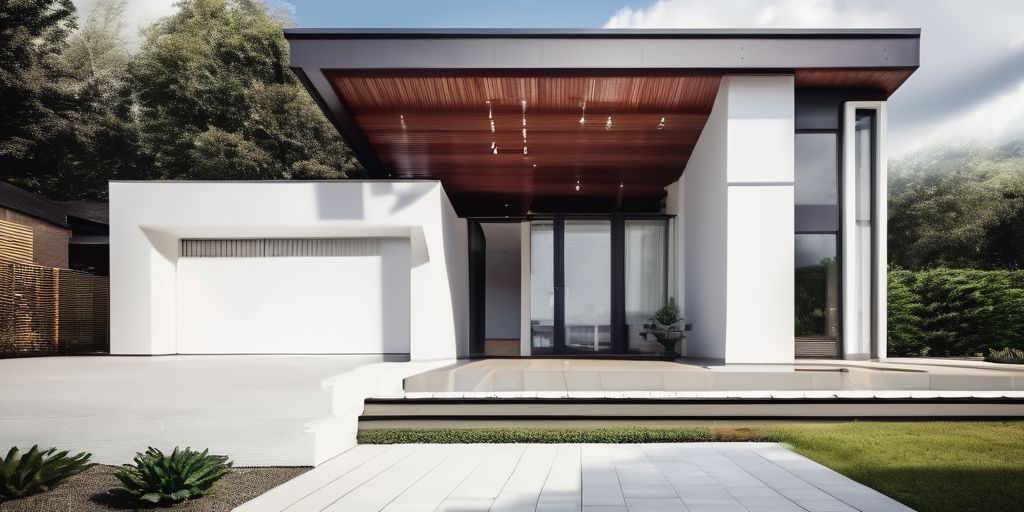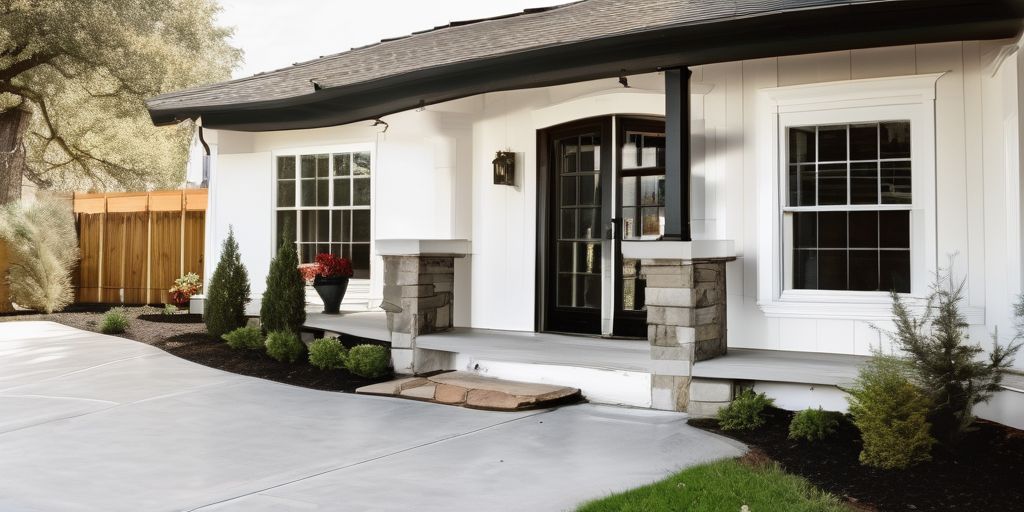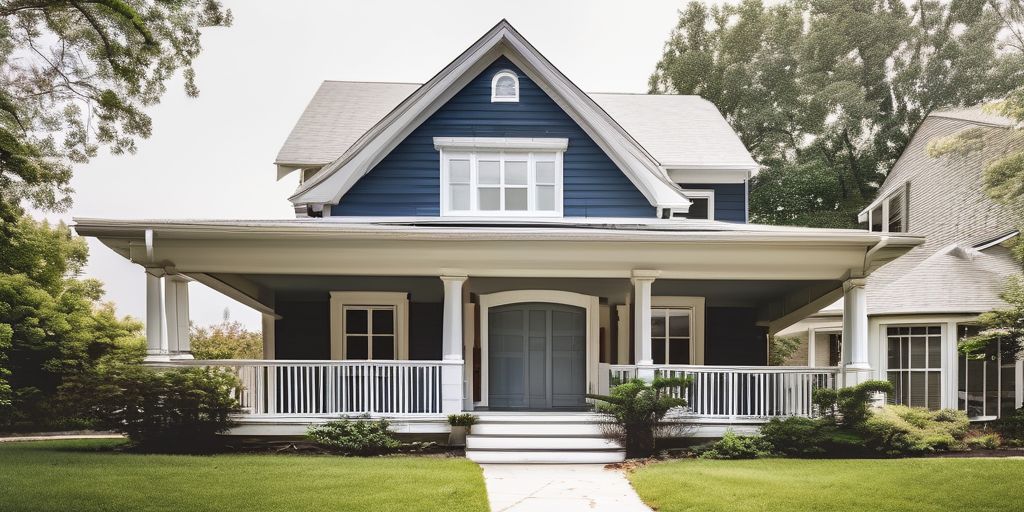Selecting the appropriate paint finish for aluminum siding is crucial for both its aesthetic appeal and longevity. This article will explore the various aspects of choosing the right paint, from understanding finishes to application techniques, ensuring that your aluminum siding remains vibrant and protected from the elements.
Key Takeaways
- Sherwin Williams Latitude in a satin finish is the best overall choice for aluminum siding, providing durability and a pleasing aesthetic.
- A rust-inhibiting primer is essential for preventing corrosion and should be applied before the topcoat to enhance the siding’s longevity.
- High-quality 100% acrylic paint is recommended for superior adherence and to withstand the elements, especially on aluminum surfaces.
- Proper preparation, including cleaning and priming, and the choice between spray or brush application, are critical for achieving a flawless finish.
- Aluminum siding typically requires repainting every 8-15 years, and professional assistance is advised for those seeking a top-notch result.
Understanding Paint Finishes for Aluminum Siding
The Importance of Satin Finish
When it comes to aluminum siding, a satin finish is often the go-to choice for homeowners. Its pearl-like sheen not only adds a touch of elegance but also offers practical benefits. Satin enamel is known for its durability and resistance to dirt, making it an ideal option for exterior surfaces.
Durability and ease of maintenance are key factors in selecting a paint finish. A satin finish strikes a perfect balance by being both easy to clean and resistant to moisture, fading, and stains. This makes it a smart choice for those looking to protect their investment while minimizing upkeep.
- Durability: Medium-High
- Resistance: Dirt, Moisture, Fading, Stains
- Applications: All exterior surfaces
Consider environmental factors, maintenance requirements, and aesthetics when choosing a finish for aluminum siding to protect and enhance your property.
Following these tips can help ensure that your aluminum siding remains vibrant and protected for years to come. Remember to assess the condition of your siding and balance the cost with the number of coats needed to achieve the desired finish.
Rust-Inhibiting Primer Essentials
When it comes to painting aluminum siding, the use of a rust-inhibiting primer is a game-changer. Primer enhances adhesion, durability, aesthetic improvement, and corrosion resistance on aluminum siding. Proper preparation and application techniques are essential for a professional, long-lasting finish. Here’s what you need to know about choosing and applying the right primer:
- Lightly Rusted Surfaces: For surfaces with minimal rust, a water or oil-based rust-preventative primer is ideal. These primers often contain zinc, which acts as a sacrificial anode to protect the metal.
- Extensive Rust: In cases of significant rust, a rust converter metal primer is the best choice. It not only stops rust from spreading but also prepares the surface for a fresh coat of paint.
Remember, the type of paint you plan to use should match the primer—never mix oil-based products with water-based ones.
Priming is not just about rust prevention; it’s also about ensuring that the paint adheres properly and looks great for years to come. Always prime all metal surfaces before painting to achieve the best results. By doing so, you’ll create a barrier that helps prevent future rust, even in areas that may not be visibly affected yet.
Testing Paint Durability on Aluminum
When it comes to aluminum siding, selecting a paint that can withstand the elements is crucial. Durability is key to ensuring your home not only looks great but is also protected over time. Here are some factors to consider when testing paint durability:
- Adhesion: The paint must adhere well to aluminum surfaces to prevent peeling and flaking.
- Elasticity: Paint should be flexible enough to expand and contract with the aluminum without cracking.
- Resistance to Corrosion: A quality paint will resist oxidation and corrosion, common issues with aluminum siding.
Maintain aluminum siding with regular cleaning and inspections. Choose durable paint for protection and aesthetic appeal. Consider compatibility with aluminum for long-lasting finish.
Choosing high-quality paint and proper preparation for aluminum siding ensures long-lasting protection and increases property value.
Remember, the longevity of your paint job is not just about the paint itself but also the preparation of the siding. A thorough cleaning and priming stage is essential before applying the topcoat. This process helps in achieving a finish that not only looks good but also lasts longer, reducing the frequency of repainting.
The Best Paint Choices for Aluminum Siding
Sherwin Williams Latitude: A Top Contender
When it comes to aluminum siding, Sherwin Williams Latitude stands out for its exceptional qualities. Its class-leading moisture resistance makes it an ideal choice for homes in humid climates, ensuring that the finish remains intact and vibrant over time. The ease of application is another significant advantage, allowing for a smooth and efficient painting process.
Sherwin Williams Latitude is not just about durability; it’s also about versatility. It can be applied over multiple surfaces, making it a go-to option for various exterior projects. Here are some key features that make Latitude a top contender:
- Class-leading moisture resistance
- Easy to brush
- Versatile application over different surfaces
The right paint can transform the look and longevity of your aluminum siding. Choosing a product like Sherwin Williams Latitude ensures that you’re investing in quality and performance.
While the initial cost may be on the higher side, the long-term benefits of using a premium product like Latitude are undeniable. It’s a cost-effective solution when considering the longevity and aesthetic appeal it provides to your home’s exterior.
Why High-Quality Acrylic Paint Matters
When it comes to painting aluminum siding, the choice of paint can significantly impact both the appearance and longevity of your home’s exterior. High-quality acrylic paint stands out for its exceptional properties, making it an ideal choice for aluminum siding projects. Here’s why:
- Durability: Acrylic paint is known for its ability to withstand the elements, resisting peeling and fading over time.
- Flexibility: It expands and contracts with the siding, reducing the likelihood of cracking.
- Mold and Mildew Resistance: Once dry, acrylic paint offers excellent resistance to mold and mildew, crucial for maintaining a clean exterior.
- UV Resistance: Acrylic paint’s UV-resistant qualities help protect the color from the harsh effects of the sun.
Selecting a high-performance paint is not just about aesthetics; it’s about choosing a product that will offer lasting protection and maintain its appearance over time. Acrylic, elastomeric, and fluoropolymer paints each provide unique benefits for longevity and appearance maintenance. For aluminum siding in Mississauga, consider these factors alongside local weather conditions to ensure your paint selection meets your needs.
Remember, meticulous preparation of the surface and regular maintenance are key to maximizing the protective qualities and curb appeal of your aluminum siding.
Choose a high-quality acrylic latex paint, and you’ll be investing in a solution that not only enhances the beauty of your home but also contributes to its protection against the elements.
The Role of Factory-Applied Primers
When it comes to painting aluminum siding, the foundation for a long-lasting finish begins with the right primer. Factory-applied primers are specifically designed to enhance paint adhesion and extend the durability of the topcoat. Here’s why they are essential:
- They create a uniform surface for the paint to adhere to.
- They help in preventing discoloration and ensure true color representation.
- They can significantly reduce the number of topcoats required, especially with deep colors.
Factory-applied primers are not just about immediate results; they are about investing in the longevity of your siding’s appearance. It’s important to note that while factory-applied primers provide an excellent base, additional priming may be necessary for optimal results, particularly when dealing with color changes or covering rust.
Professional advice is recommended for painting aluminum siding. Steps include cleaning, priming, and selecting high-quality paint for durability. Safety gear and proper preparation are crucial for a lasting finish.
Remember, the goal is to achieve a flawless finish that stands the test of time. Ensuring that your aluminum siding is properly primed before painting is a step you cannot afford to skip.
Application Techniques for a Flawless Finish
Preparing the Siding for Painting
Before an exterior painter can begin transforming your aluminum siding, proper preparation is crucial. Here’s a simple guide to ensure your siding is ready for a fresh coat of paint:
- Clean the siding thoroughly to remove any dirt, debris, or mildew. A power washer can be highly effective for this step.
- Protect areas not being painted with painter’s tape and coverings. This includes windows, doors, and any adjacent brickwork or landscaping.
- If necessary, apply a primer specifically designed for aluminum siding. This step may vary depending on the existing condition of your siding.
Ensuring your siding is impeccably prepared is the foundation for a paint job that not only looks stunning but also provides lasting protection against the elements.
Remember, expertise in meticulous siding painting preparation and application is key for lasting beauty with high-grade products for lasting protection.
Spray vs. Brush Application
When it comes to applying paint to aluminum siding, homeowners and professionals alike are faced with two primary methods: spray or brush application. Each technique has its own set of advantages that cater to different needs and preferences.
Spray painting on aluminum surfaces offers a flawless finish, durability, and versatility. It’s particularly effective for covering large areas quickly and achieving uniform coverage. This method is often favored for its efficiency and the ability to maintain a consistent mil thickness across the siding.
On the other hand, using a brush or roller provides the precision needed for detailed work around trim, doors, and windows. It’s also the go-to choice for those who prefer a hands-on approach or do not have access to a sprayer. Here are some tips for brush application:
- Use a high-quality nylon/polyester brush for precision.
- Maintain a wet edge to avoid lap marks.
- Inspect the surface for imperfections as you go.
- Ensure color and sheen uniformity by intermixing containers of the same product.
Remember to allow each coat to become touch-dry before applying the next one, and always use quality tools for the best results.
Ultimately, the choice between spray and brush application will depend on the specific requirements of your project, your skill level, and the tools at your disposal.
Timing Your Repainting Schedule
Determining the optimal schedule for repainting your aluminum siding is crucial for maintaining its appearance and integrity. Properly plan your painting project to ensure a balance between efficiency and quality. Here are some tips to guide you:
- Work in sections to manage your workload and maintain consistency.
- Take regular breaks to avoid fatigue, which can lead to mistakes.
- Use premium tools for a more professional finish and easier application.
Remember, the goal is to achieve a durable finish that protects your home and enhances its beauty. Avoid common mistakes like skipping primer and rushing the process.
When choosing the right paint, consider factors such as safety, the size of your home, and the local climate. High-quality acrylic paint is essential for durability and weather resistance, especially in areas with unique environmental conditions, like those near the Welland Canal or St. Catharines City Hall. A thorough preparation of the surface and the use of the right sprayer can lead to an even application and a flawless finish.
Cost-Effective Solutions for Siding Maintenance
Budget-Friendly Paint Options
When it comes to maintaining aluminum siding, finding a balance between cost and quality is key. Latex paint emerges as a budget-friendly champion, offering a myriad of benefits that don’t break the bank. Here’s why latex paint can be your ally in cost-effective siding maintenance:
- Affordable: It’s generally less expensive than other types of paint.
- Eco-friendly: With minimal odor and low levels of VOCs, it’s a responsible choice for the environment.
- Efficiency: Dries quickly and covers surfaces with fewer coats.
- Maintenance: Easy to clean and doesn’t trap moisture, which is crucial for aluminum surfaces.
Durability and aesthetics shouldn’t be compromised for affordability. Choose eco-friendly paints with low VOCs, biodegradable ingredients, natural pigments, and recycled content for aluminum siding. Consider compatibility with aluminum surfaces for long-lasting durability and aesthetics. Regular cleaning, inspection, and touch-ups are essential for longevity, ensuring your siding remains both beautiful and energy-efficient.
While the initial cost is an important factor, remember that the longevity and performance of the paint can lead to greater savings over time. Opting for high-quality paint tailored for aluminum siding maintenance can prevent frequent repaints and reduce overall expenses.
Longevity and Performance Considerations
When it comes to aluminum siding, the longevity and performance of your paint finish are paramount. Choosing premium paints with additives specifically designed for aluminum siding can significantly enhance the lifespan of your siding. These paints often include features such as UV resistance and flexibility, which are essential for withstanding the elements.
- Proper surface preparation
- Use of rust-inhibiting primers
- Application of high-quality acrylic paints
These steps are crucial for ensuring durability in varying climates, as they help the paint adhere better and resist wear and tear. Regular maintenance, including periodic cleaning and touch-ups, also plays a vital role in extending the life of your paint job.
Environmentally friendly paint options not only contribute to siding sustainability but also promote a healthier environment. By selecting low-VOC latex paints, you can achieve a balance between eco-friendliness and performance.
Remember, while cost is an important factor, investing in quality paint and proper application techniques can save you money in the long run by reducing the frequency of repainting. The table below summarizes key points to consider for maintaining your aluminum siding’s appearance and integrity over time.
| Factor | Importance |
|---|---|
| Paint Quality | High |
| Surface Preparation | Critical |
| Maintenance | Regular |
| Environmental Impact | Considerable |
Dealing with Old Homes and Peeling Paint
When addressing the challenge of peeling paint on older homes, it’s essential to understand that the right paint can make a significant difference. Top-quality paint is designed to expand and contract with the siding, adapting to temperature changes without the common issues of peeling, blistering, or cracking.
- Preparation: Start by thoroughly cleaning and sanding the siding to ensure a smooth surface.
- Choice of Paint: Opt for water-based or latex paints, which are less harmful and better for the environment than traditional oil-based options.
- Application: Apply the paint evenly and allow sufficient drying time between coats.
Remember, a fresh coat of paint not only enhances your home’s curb appeal but also provides protection against the elements.
For homes with a history of paint problems, it’s crucial to address any underlying issues before repainting. This might include repairing damaged siding or improving ventilation to prevent moisture buildup. By taking these steps, you can help ensure a long-lasting, beautiful finish for your home’s exterior.
Color Selection and Professional Assistance
Choosing the Right Color for Your Home
Selecting the perfect color for your aluminum siding is more than just picking a favorite shade. It’s about creating a harmonious blend with your home’s existing elements and the surrounding environment. Choosing the right shade of blue, for example, involves considering the existing color scheme, landscape, and architectural style. Proper preparation and multiple coats may be needed for applying blue paint.
When considering siding color for your home in Cambridge, it’s crucial to think about the architectural style, local environment, climate, and personal taste. Professional painting and maintenance are essential for a lasting impact and to ensure your home stands out for the right reasons.
Vibrant aluminum siding colors not only enhance curb appeal but also add value to your home. Aluminum siding offers durability, longevity, and low maintenance, making it a wise investment.
Remember to check with your homeowners association (HOA) for any color guidelines and to consider how your roof and landscaping will impact your paint choices. If you’re unsure which paint color to choose, request color samples from your local home improvement store or a painting professional and view them in full sunlight.
When to DIY and When to Call the Pros
Deciding whether to DIY or seek professional help for your aluminum siding project can be a tough call. Here’s a quick guide to help you make an informed decision:
- DIY if:
- You have experience with painting projects.
- You’re comfortable with the necessary safety measures.
- You have the time and patience for meticulous work.
- Call the Pros when:
- The project scale is beyond a one-person job.
- Specialized equipment is required.
- You’re unsure about the proper techniques or materials.
Remember to properly prepare and clean aluminum siding before painting. Test paint samples in different lighting to ensure the chosen color looks great throughout the day. If in doubt, consulting professionals can lead to the best results, especially when choosing durable paint for long-term protection.
While DIY can be rewarding, the expertise of a professional ensures a flawless finish and long-lasting durability. Consider the complexity of your project and your own skill level before taking the plunge.
Understanding Paintable Siding Materials
When it comes to refreshing the look of your home, not all siding materials are created equal. Paintable siding materials offer the flexibility to change colors and enhance curb appeal. Here’s a quick guide to some common materials you can paint:
- Wood Siding: Known for its classic look, wood siding accepts paint well but may require more frequent maintenance.
- Aluminum Siding: A durable choice that pairs well with satin finish paints for a sleek appearance.
- Vinyl Siding: While not all vinyl siding is suitable for painting, specific types designed for paint adherence can be refreshed.
- Cement Siding: Requires no priming and holds paint for extended periods, making it a low-maintenance option.
Choosing the right paint for your siding material not only boosts your home’s aesthetic but also its protection against the elements.
Each material has its own set of preparation steps and maintenance requirements. For instance, while cement siding is low-maintenance, wood siding may need more attention to ensure longevity. It’s essential to understand these nuances to make an informed decision and achieve the best results for your home.
Choosing the right color for your home’s exterior can be a daunting task, but with our professional assistance, it’s a breeze. At We Paint Siding, we specialize in bringing new life to your aluminum siding with a range of vibrant colors and a finish that lasts. Don’t let color selection overwhelm you—visit our website to book a free estimate and explore our extensive services. We’re dedicated to providing you with a seamless experience and a stunning home transformation. Click now to start your journey to a beautifully painted home with the experts at We Paint Siding!
Conclusion
Choosing the right paint finish for your aluminum siding is crucial for both aesthetics and longevity. With options like Sherwin Williams Latitude in Satin being the best overall, and specific considerations for corrosion and the need for rust-inhibiting primers, you’re now equipped to make an informed decision. Remember, while DIY painting can be rewarding, it’s often a task best left to professionals for a flawless finish. Whether you’re refreshing your home’s exterior or protecting new siding, the right paint can make all the difference. Happy painting!
Frequently Asked Questions
What is the best paint finish for aluminum siding?
The best paint finish for aluminum siding is a satin finish, which offers a balance between a soft sheen and easy maintenance. Sherwin Williams Latitude in satin is highly recommended for its durability and overall performance.
How often should aluminum siding be repainted?
Aluminum siding should typically be repainted every 8-15 years, depending on the quality of the paint used and the environmental conditions to which the siding is exposed.
Do I need to use a primer before painting aluminum siding?
Yes, it is important to use a rust-inhibiting primer before painting aluminum siding to prevent corrosion and ensure better adhesion and longevity of the paint.
Is it better to spray or brush paint aluminum siding?
Spray application is often preferred for aluminum siding as it creates a more uniform, attractive finish without brushstrokes. However, brushing can be effective for detail work and smaller areas.
What are some cost-effective paint options for aluminum siding?
For budget-friendly options, consider paints like Benjamin Moore Ultra Spec, which provides good performance at a lower cost. For homes with peeling paint, Benjamin Moore Peel Bonding Primer is recommended.
Should I paint my aluminum siding myself or hire professionals?
Painting siding can be a tedious task. If you have experience with DIY painting projects, you may tackle it alone. However, for a top-notch job, especially on larger or more complex projects, it’s often best to hire professionals.










